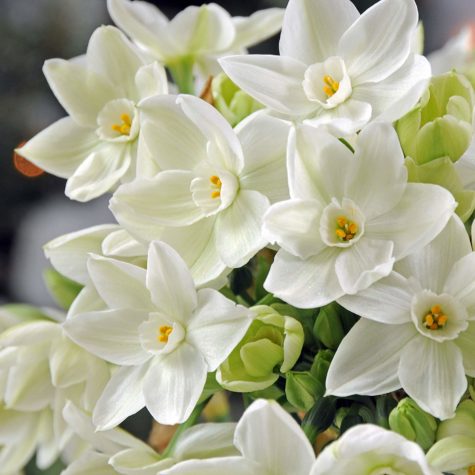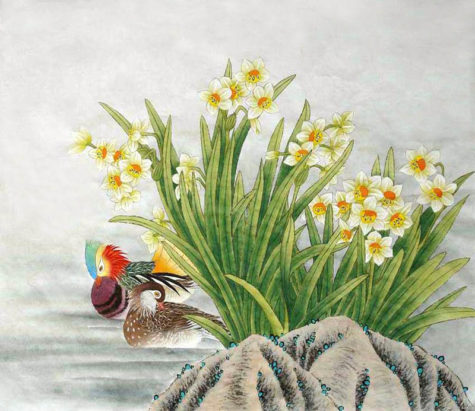- Ruler: Dionysus
- Type: Plant
- Sign: Virgo
- Tarot Card: The Hermit
- Magickal Form: Flower, Essential Oil
The Narcissus is often assigned to the month of December, and is also associated with the Chinese New Year which occurs in February.
Wear this scent to entice others and promote self-love and self-confidence. Overuse can attract stalkers and create egomaniacs – so don’t over do it. Rub on pink candles to meet new people. Rub black Narcissus oil on black candles for self-hypnosis. Use the oil on red candles to hypnotize and bewitch another.
In China, for centuries, narcissus bulbs have been placed in bowls with rocks and water. They are then “forced” into flowering by the Chinese New Year to acquire good fortune.
This old-fashioned flower for late spring is famous for its fragrance, which is one of the most expensive in the world. The Romans made a perfume from this flower, and it featured in early Arab perfume as well. The scent is a combination of jasmine and hyacinth. Its fragrance affects the nervous system (Mercury again), relieving stress.
These beautiful flowers emit sweet, lovely fragrances long used to manifest new relationships or to enrich the love already shared with another. The purple varieties seem to be best for this use. In the Middle East, the scent is thought to be aphrodisiac.
Magickally, this old-fashioned flower is dedicated to virgins, hermits, those who practice a solitary spirituality, and people who just enjoy being alone. Reasonably, it is connected to the sign of Virgo and the Hermit card. Venus bathed in narcissus flowers before winning a contest of beauty against Juno and Diana, but the plant is sacred to Adonis.
You would think then that this magick herb would be associated with the Sun, but instead it is considered a Mercury herb. Its name comes from the word for “stuck dumb” due to the power of its poisons to take away speech, which Mercury rules. Narcissus is specific for Mercury magickal works, such as those leading to parthenogenesis and invisibility.
Narcissus vs Daffodil
Though their botanic name is Narcissus, they are often also called daffodils, and sometimes jonquils, or paper whites. In England, because of their long association with Lent, they’re known as the “Lent Lily.”
The term “Daffodil” commonly refers to Narcissus with large trumpets, but may be used for all types of Narcissus . This is the official common name for ANY of the plants that fall into the genus Narcissus. So, if the plant is considered a Narcissus, it is also considered a daffodil as well. However, most people use the term “daffodil” when referring to the large, trumpet-shaped flowers of the Narcissus pseudoNarcissus .
- In Victorian flower language daffodils signified regard and chivalry, whilst the Narcissus meant self esteem, female ambition or vanity.
You can read more about the magickal properties of the Daffodil here: Daffodil Magick and Lore.
Narcissus in Mythology
The Narcissus is named after the legendary young Greek man of the same name. Narcissus was pretty full of himself because he had been given the gift of great beauty by the gods. One day, a sweet young wood nymph named Echo spotted Narcissus hanging out by a stream and instantly fell in love with him. However, he was so busy being completely self-absorbed that he ignored Echo, and she wasted away from loneliness until nothing was left of her but her voice. Thanks to this tragic story of unrequited love, the Narcissus is sometimes used to represent a love that is one-sided.
Later, the goddess Nemesis, although in some versions, it’s Venus, got wind of what had happened to Echo, so she decided it was time to teach Narcissus a lesson. She led him to a stream, where he happened to notice the most beautiful young man he had ever seen – it was his own reflection, and he was so vain that he fell in love with his own image, transfixed, and forgetting to eat and sleep. Some of the other gods were worried that Narcissus was going to starve to death, so they turned him into a flower, which now blooms every year in the spring.
- Alternatively
It is possible that this plant wasn’t named after the youth who fell in love with his reflection in a pool of water. Pliny states that the name was derived from the word “narkao, to benumb, due to the plant’s dramatic effects on the nervous system when taken internally. Never eat any part of this plant.
- Bean Magick and Lore by shirleytwofeathers - 6 Comments
- Purple Loosestrife Magick and Lore by shirleytwofeathers - 5 Comments
- Onion Magick and Lore by shirleytwofeathers - 4 Comments
- Magickal Uses of Mud Dauber Dirt by shirleytwofeathers - 4 Comments
- Herbs by Gender by shirleytwofeathers - 4 Comments
Michaela Renee Solomon: Bean Magick and Lore
Alex Jinn: Holy Water
Lilith Linlithgow: AZaJ2zpS1xg
Tina from Magickal Spot: Ingwaz Rune Magick
Tina from Magickal Spot: Thurisaz Rune Magick






Leave a Reply